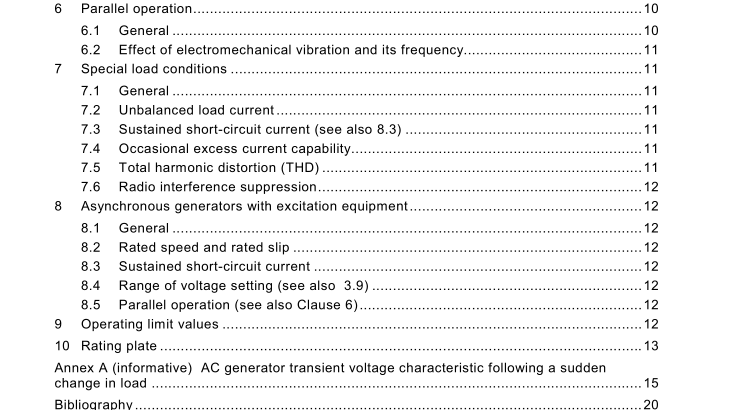IEC 60034-22:2009 pdf download – Rotating electrical machines – Part 22: AC generators for reciprocating internal combustion (RIC) engine driven generating sets
NOTE 3 When generating sets are operating in parallel with star points directly connected together, circulating currents may occur, particularly third harmonic currents. Circulating currents can increase the r.m.s. current which may reduce the thermal life expectancy of the insulation system.
6.2 Effect of electromechanical vibration and its frequency It is the responsibility of the generating set manufacturer to ensure that the set shall operate stably in parallel with others, and the generator manufacturer shall collaborate as necessary to achieve this. If there is a RIC engine torque irregularity at a frequency close to the electromechanical natural frequency, resonance will occur.
The electrical natural frequency usually lies in the range of 1 Hz to 5 Hz, and hence resonance is most likely to arise with low speed (1 00 min –1 to 1 80 min –1 ) RIC engine generator sets. In such cases, the generating set manufacturer shall be prepared to give advice to the customer, assisted by a system analysis if necessary, and it is expected that the generator manufacturer will assist in such investigation.
7 Special load conditions
7.1 General In addition to the conditions given in IEC 60034-1 , the requirements given in 7.2 to 7.6 shall apply. NOTE Consideration of the variation of these requirements from IEC 60034-1 will assist in the specification of special load conditions.
7.2 Unbalanced load current Limiting values shall be in accordance with 7.2.3 of IEC 60034-1 , except that generators with ratings up to 1 000 kVA, which are intended to be loaded between line and neutral, shall be capable of operating continuously with a negative phase sequence current up to and including 1 0 % of the rated current.
7.3 Sustained short-circuit current (see also 8.3) Sustained short-circuit current is attained by an excitation system of a synchronous generator designed to provide a specified value of short-circuit current for a specified period of time. The value of sustained short-circuit current shall be decided by agreement between purchaser and manufacturer. NOTE 1 Under short-circuit conditions on a synchronous generator, it may be necessary to sustain a minimum value of current (after the transient disturbance has ceased) for a sufficient time to ensure operation of the system’s protective devices. NOTE 2 Sustained short-circuit current is not necessary in cases where special relaying or other designs or means are employed to otherwise achieve selective protection, or where no selective protection is required.
7.4 Occasional excess current capability Short-term excess current capability shall be in accordance with 9.3.2 of IEC 60034-1 . 7.5 Total harmonic distortion (THD) Limiting values of the total harmonic distortion of the line-to-line terminal voltages shall be in accordance with 9.1 1 of IEC 60034-1 . When tested on open-circuit and at rated speed and voltage, the total harmonic distortion of the line-to-line terminal voltage shall not exceed 5 %.
7.6 Radio interference suppression Limiting values of radio interference for continuous and clicking disturbances shall be in accordance with CISPR 1 1 . The grade of radio interference suppression involves the interface voltage, power and field strength. This shall be decided by agreement between purchaser and manufacturer.
8 Asynchronous generators with excitation equipment 8.1 General Asynchronous generators need reactive power for voltage generation. When running in isolation, special equipment is necessary to provide their excitation, and this equipment also has to supply the reactive power demand of the connected load. The following terms and notes are valid for asynchronous generators which are not connected to the power grid for supplying the required reactive power but are provided with specially incorporated excitation equipment.
8.2 Rated speed and rated slip
(For definitions, see Clause 3.)
8.3 Sustained short-circuit current
(For definition, see 7.3.)
NOTE Asynchronous generators deliver an occasional sustained short-circuit current only when provided with especially equipped excitation sources.
8.4 Range of voltage setting (see also 3.9)
To provide a range of voltage adjustment for asynchronous generators special controllable excitation equipment is required.
